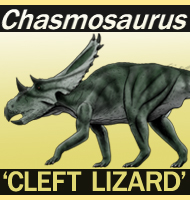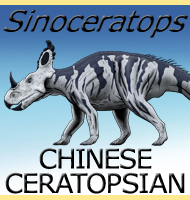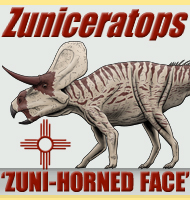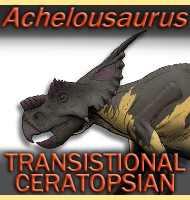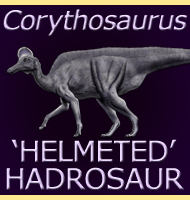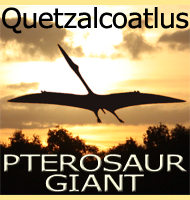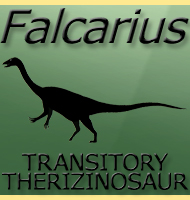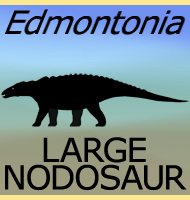


Pachyrhinosaurus
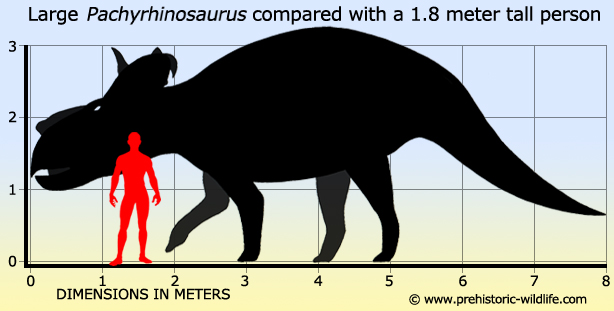
Name:
Pachyrhinosaurus
(Thick nosed lizard).
Phonetic: Pack-ee-rye-no-sore-us.
Named By: Charles Mortram Sternberg - 1950.
Classification: Chordata, Reptilia, Dinosauria,
Ornithischia, Ceratopsia, Ceratopsidae, Centrosaurinae,
Pachyrostra.
Species: P. canadensis
(type), P.
lakustai, P. perotorum.
Diet: Herbivore.
Size: 8 meters long.
Known locations: Canada, Alberta - Bearpaw
Formation, Horseshoe Canyon Formation. USA, Alaska - Prince
Creek Formation.
Time period: Campanian of the Cretaceous.
Fossil representation: Skulls of many individuals as
well as hundreds of associated bones.
Even though it did not have the elaborate horns of some ceratopsians like Einiosaurus, Pachyrhinosaurus has become a favourite amongst ceratopsian dinosaur enthusiasts because of the large bony growth called a boss that is present on top of its snout. A second smaller boss was also present over the eyes and is sometimes close to the nasal boss. Pachyrhinosaurus still possessed some small horns, particularly around the edges of the frill. Some of these characteristics are shared amongst the Pachyrhinosaurus species while some are unique to just one species.
Distinguishing characteristics of Pachyrhinosaurus species| Distinguishing feature | P. canadensis | P. lakustai | P. perotorum |
| Eye and snout bosses almost together? | Yes | No | Yes |
| Two curved backwards pointing horns on frill? | Yes | Sometimes | No |
| Jagged 'comb' extension on tip of nasal boss? | No | Yes | Yes |
| Narrow dome in centre of upper portion of nasal boss? | No | No | Yes |
| Pommel on the front of nasal boss? | No | Yes | No |
| Two flattened horns that point forwards and down from top of frill? | Yes | No | No |
| Flat and rounded nasal boss? | Yes | No | No |
| Comb-like horn rising from middle of frill behind the eyes? | No | Yes | No |
| Known formations for the species | Horseshoe Canyon | Bearpaw, Horseshoe canyon | Prince Creek |
The
first Pachyrhinosaurus fossils were actually
discovered way back in
1880, but they did not get the attention they deserved until the
late 1940s which would result in the establishment of the type
species in 1950. The most significant discovery relating to
Pachyrhinosaurus however was the excavation of the
Pipestone Creek bone
bed in the late eighties (originally discovered by Al Lakusta in
1972) which ultimately yielded three and a half thousand
Pachyrhinosaurus bones as well as fourteen skulls.
These bones
represent individuals of all ages from fully grown adults to
juveniles, suggesting that ceratopsians like Pachyrhinosaurus
moved
around in herds, possibly as a protection against large tyrannosaurid
predators like Albertosaurus.
One
explanation for this bone bed occurring is that the Pachyrhinosaurus
were crossing a river that may have been swollen with flood water,
resulting in treacherous conditions that claimed the lives of many of
the herd. Similar bone beds are also known for other ceratopsian
dinosaurs like Centrosaurus
and Styracosaurus.
Specimens from this
bone bed display a mix of convex (curved outward) and concave
(curved inward) bosses. While speculation for this has been cited
as representing male and female specimens, the differences may have
been caused by erosion of the material. Individuals from this bone
bed were named Pachyrhinosaurus lakustai after Al
Lakusta.
Further reading
- Pachyrhinosaurus canadensis, representing a new
family of the
Ceratopsia, from southern Alberta - National Museum of Canada Bulletin
118:109-120 - Charles M. Sternberg - 1950.
- The thick-headed ceratopsian dinosaur Pachyrhinosaurus
(Reptilia:
Ornithischia), from the Edmonton Formation near Drumheller, Canada -
Canadian Journal of Earth Sciences 4:171-186 - W. Langston - 1967.
- A further note on Pachyrinosaurus (Reptilia:
Ceratopsia) - Journal of
Paleontology 42(5):1303-1304 - W. Langston - 1968.
- A new species of Pachyrhinosaurus (Dinosauria,
Ceratopsidae) from the
Upper Cretaceous of Alberta, Canada - in A New Horned Dinosaur from an
Upper Cretaceous Bone Bed in Alberta. NRC Research Press, Ottawa 1-108
- P. J. Currie, W. Langston & D. H. Tanke - 2008.
- A new species of the centrosaurine ceratopsid Pachyrhinosaurus
from
the North Slope (Prince Creek Formation: Maastrichtian) of Alaska -
Acta Palaeontologica Polonica 57 (3): 561–573 - Anthony R. Fiorillo
& Ronald S. Tykosk- 2012.
- An Immature Pachyrhinosaurus perotorum
(Dinosauria: Ceratopsidae)
Nasal Reveals Unexpected Complexity of Craniofacial Ontogeny and
Integument in Pachyrhinosaurus - PLoS ONE 8(6) -
Anthony R. Fiorillo
& Ronald S. Tykosk- 2013.
----------------------------------------------------------------------------
Random favourites

|
 |
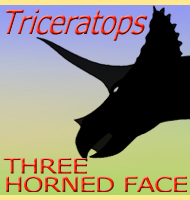 |

|
